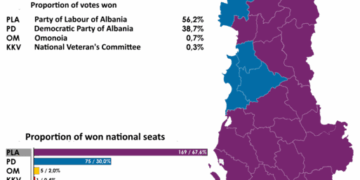By Zvi Shalem
How woke ideology captured academia—and why we must understand the enemy before we can resist it
In late 2023, physicist Sabine Hossenfelder posted on X about a surreal experience:
“I wrote a research proposal about inflation (in the early universe, not in your supermarket) and it bounced back because I didn’t explain its relevance to ‘sex, gender, and diversity’. I need to add a paragraph on this. Anyone has an idea what to write?”
She deleted the tweet the same day—not because the claim was disputed, but because she had broken an unspoken rule. She exposed the liturgy. And the response wasn’t scientific disagreement—it was ideological enforcement.

It wasn’t enough to comply. She was expected to affirm. To participate in what Orwell called “not only saying, but believing, that 2 + 2 = 5.”
This wasn’t an isolated incident. The more we look, the clearer it becomes: subversion has occurred—and it is anything but accidental.
Consider this quote from a real, peer-reviewed article in Progress in Human Geography, titled “Glaciers, Gender, and Science: A Feminist Glaciology Framework for Global Environmental Change Research”:
“Cooked food, especially fat, might grow into a glacier overnight if improperly handled… The narratives… demonstrate the capacity of folk glaciologies to diversify the field of glaciology and subvert the hegemony of natural sciences.”
“Subvert the hegemony of natural sciences.” Not critique. Not expand. Subvert.
If this were a blog post or activist pamphlet, we could dismiss it. But this is published in a scientific journal. And it reflects a growing pattern—across disciplines and institutions—of replacing truth-seeking with ideology enforcement.
We all may stop asking whether something is wrong. Something is very wrong. This is an ideological occupation of science.
Why Science Didn’t See It Coming
How did this happen? How did some of the most brilliant minds in the world fail to notice?
Because scientists, trained in objectivity, are not accustomed to thinking in terms of power based on deep manipulation. But the architects of this ideology are. They don’t view truth as a neutral goal—they see it as an obstacle.
As Alison Bailey wrote in her 2020 paper Tracking Privilege‐Preserving Epistemic Pushback in Feminist and Critical Race Philosophy Classes:
“To extend Audre Lorde’s classic metaphor, the tools of the critical-thinking tradition (for example, validity, soundness, conceptual clarity) cannot dismantle the master’s house: they can temporarily beat the master at his own game, but they can never bring about any enduring structural change.”
In other words, logic and clarity are not helpful—they’re oppressive. If clarity shows that a method doesn’t work, then clarity itself becomes the problem.
This is formalized insanity.
These ideologues don’t just misunderstand the norms of rational inquiry—they understand them all too well—as hindrance or as a target of subversion.
The Two Faces of the Movement
To grasp how this ideology spreads, we must distinguish between two key groups:
- The Dogmatic Antagonists – These are students and academics who equate critique with virtue. They believe that the height of moral and intellectual achievement is to find ever more things to denounce.
- The Strategic Antagonists – These are the architects. They are not swept up in the antagonism—they direct it. They understand the rules of rational discourse and how to subvert them in order to gain power. They seek power—and they’ve been remarkably successful.
The Three Pillars of Woke Ideology
Woke ideology, as it relates to the strategic antagonists, is not just a collection of “progressive ideas”. It is a structured belief system with coherent internal logic, strategic objectives, and metaphysical assumptions.
Its power lies not in persuasive argument, but in its ability to dominate the institutions that shape what counts as truth. It rests on three pillars:
1. Projected Ethos: The Noble Lie of Moral Authority
By claiming to represent “the oppressed,” the ideologue assumes unearned moral authority. This shields them from critique and grants control over others. Plato called this kind of myth a Noble Lie—a socially strategic untruth that justifies hierarchy.
2. Goal: Institutionalizing the Noble Lie
Once this moral authority is established, it becomes a lever for institutional capture. Following the neo-Marxist vision of the ‘long march through the institutions,’ the movement infiltrates education, media, science, and law—not to advance their stated missions, such as knowledge production in the case of academia, but to enforce ideological conformity.
3. Epistemology: The Metaphysical License to Reshape Reality
At its root lies a belief in a metaphysical “history god”—a sacred arc of progress that, conveniently, culminates with the ideological vanguard in power. Inspired by Hegel’s dialectic, shaped by Marx, and institutionalized over time through neo-Marxist critical theory, this framework rejects all limiting principles—be they tradition, morality, or reason itself.
The result is a worldview that first sees itself and then presents itself as inevitable, morally infallible, and beyond scrutiny.
A New Line in the Sand
This is not just a culture war. It’s an epistemological war.
Science and woke ideology cannot peacefully coexist in the same institution. They clash not just over values—but over the nature of truth, the meaning of inquiry, and the role of the individual in relation to power.
We need more than appeals to free speech or better public science communication. We need a clear understanding of what this ideology is, how it operates, and how to resist it.
This is not only about defending science—it’s about preserving the intellectual immune system of an entire civilization.
That’s why I wrote the Science vs. Woke manifesto:
The manifesto is part of a broader effort to come to grips with the reality we now face. What happens next depends on our willingness to name the threat—and to respond with clarity, courage, and integrity.

































